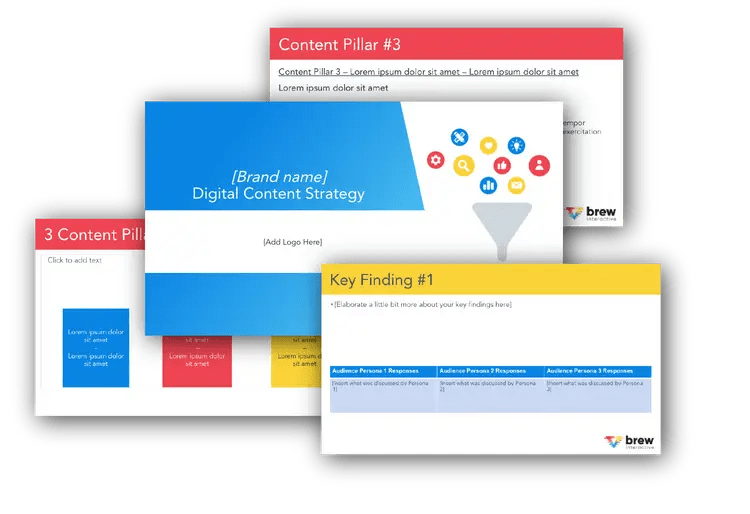Do you ever feel like you’re putting out a lot of content – on your blog, your social media channels, your email campaigns – but not getting the returns you envisioned? And worse yet, you’re spending a ton of time on it?
You need an approach to content strategy that not only works, but doesn’t take up all of your marketing team’s time.
Enter: Content Pillars.
You may have heard of content pillars, but have confused them with content hubs, clusters, hubs, spokes, etc… We’ll help clarify exactly what they are and how they can be used to accelerate your content marketing, SEO, and social media efforts.
In this post we’ll dive into:
- The Basics of Content Pillars
- How to Implement Content Pillars
- Some Content Pillar Examples
What Are Content Pillars?
Content pillars are the primary topics on which your brand is an expert.
Content pillars can be implemented through content, SEO tactics, and social media – but at their core, they are simply topics your brand will consistently discuss, educate on, and amplify to your audience.
Another word for a content pillar might be topic cluster or a content hub.
In content marketing and SEO, a content pillar is often a single piece of substantive content on one of your primary topics. Content pillars are usually broken down into lots of smaller subtopics, typically linking to additional content.
Within content marketing and B2B SEO, many like to use the terms topic clusters, content hub or hub and spoke. Within these models, your piece of pillar content is your central hub, with spokes linking to and from it.
Within social media, a content pillar isn’t necessarily a single piece of content, but more like a category of content you’ll post about regularly. You might hear them referred to as content buckets or content categories (more on this below).
You’ll establish a few topics you want to cover extensively and work them into your content calendar over time.
We’ll look at some B2B examples below, but let’s look at a simple example to kick us off:
Consider a pet store that primarily sells dogs. They’ve decided their content pillars will be:
- Dog Breeds
- Dog Care
- Dog Training
Underneath the topic of dog care, they’ve chosen 4 subtopics: dog food, walks, veterinary care, and traveling with your dog.
To establish this pillar, the pet store writes a complete guide to caring for your dog. It’s a long article with over 2000 words. The article is broken down into sections based on their subtopics, with each section linking to a more in-depth post on that subtopic.
The pet store will then use this pillar post to populate three months’ worth of their content calendar on caring for dogs. They might also make a few videos and infographics pulling from the pillar that can be posted to social platforms and shared via email.
Sounds great right, but what’s the benefit of content pillars? There are three key benefits:
Establish Authority & Trust
First, content pillars help us establish authority and trust on the most important topics for our audience. Do you ever land on a company’s blog and see a random hodge-podge of news announcements, recent hires, and just a few 250 word blog posts?
Do you feel confident this company is an expert? Do you feel they’re an authority on their subject matter?
On the other hand, when you land on a blog with well organized and in-depth content, you’re more likely to see them as an authority in the field – especially when your content pillars are closely tied to your unique selling proposition.
Sage highlights some key categories up top, as well as a few relevant pillars specific to business size. Content like this establishes authority and builds trust.
Efficient Production and Distribution
On top of being an authority builder, content pillars make content efforts more efficient and organized.
Content pillars create a predefined system for repurposing content.
Instead of racking your brain every week to decide what you’ll post about, you already have a good idea of what topics and subtopics need to be covered. Once you’ve published content, you can then easily pull out bite sized pieces for social platforms or spin a paragraph into a video or infographic.
This trickle-down approach to content makes distribution much more straightforward than having to reinvent the wheel every month.
SEO Boost
Using content pillars along with a cluster model helps search engines more easily crawl your site, understand what kinds of topics and subject matter you cover, and see you as a topical authority in your niche.

Free B2B Content Strategy Template
Not sure where to start when it comes to your content strategy? Struggling to gain traction? Grab our free B2B content strategy template to help you document your strategy.
Search engines like Google often reward sites who thoroughly cover topics and organize their content in a logical way.
Content Pillars in Your Social Media Strategy
We didn’t want to go further without mentioning content pillars’ role in social media. When it comes to social media strategy and marketing, content pillars serve a similar function as they do in content marketing – and for many brands, the same pillars probably apply to both.
Content pillars are 3 to 6 topics your brand will consistently discuss, amplify, and create content for on social media. These are the primary topics your business has expertise in. Establishing your pillars for social strategy will help you plan content, establish authority in the industry, and create a consistent presence on social platforms.
How Do You Make Content Pillars?
Let’s get a little more specific on how to create and implement content pillars:
1. Choose Your Pillars
The first step is to determine the core topics and subtopics you want to focus on as a brand. These pillars should be the perfect blend of your company’s expertise and your audience’s interests.
Here are a few things that make a great content pillar:
- It’s substantial enough to merit a content hub
- It’s broad enough to sustain an ongoing content calendar
- It has at least 3-4 fairly obvious subtopics
- There is adequate search volume for the main topic and subtopics
- You have the expertise to generate quality, valuable content around it
Advice on Choosing Pillars:
Don’t just assume your audience is interested in a topic. Run extensive customer research to identify these high-level topics. Hold live interviews with both customers and prospects to dive into their interests, challenges, and aspirations.
2. Create Your Pillar Content Pieces
Now that you’ve chosen your content pillars and subtopics, it’s time to create your pillar content pieces.
These pieces of content should be thorough and valuable. They should at minimum introduce every question a prospect might have on the topic and link to supporting content on each subtopic.
There are three main types of pillar content when it comes to blog posts:
- The “How To” Article: These articles are perfect for topics that are ultra practical. They provide easy-to-follow instructions related to the pillar. These are perfect for subject matter that’s practical in nature and doesn’t require much explanation. For example, a financial firm with a content pillar on small business taxes might write a how-to article as their pillar content. No one reading it needs to know what taxes are. They just need advice on how to file their own.
- The Guide: Guides should provide an authoritative overview of the topic and link to lots of supplementary material. Guides are perfect for big, lofty topics that couldn’t possibly be covered in one post. For example, our financial firm might use a guide to tackle their pillar on investing. There’s no one-size-fits-all approach, and the topic is massive.
- The “What Is” Article: These articles are best for topics that aren’t general knowledge. Nearly everyone knows what investing is. A guide to investing only needs to briefly introduce the concept, whereas a pillar on portfolio allocation might need more baseline explanation.
Advice on Writing Pillar Content:
These pieces are at the heart of your content strategy. Take your time on them and make them truly valuable. Get outside quotes, use examples, include helpful graphics, and don’t rest until you have the best piece of content on the topic.
3. Create Cluster Content
Now that you have your pillar, you need to create cluster content around it.
In step one, you outlined your primary subtopics, which you should have touched on in your pillar content. Now, it’s time to create dedicated content for each of those subtopics. These posts can also be called cluster content.
These posts don’t have to be quite as expansive, but they should cover the subtopic in a comprehensive and helpful way.
Advice on Writing Cluster Content:
Cater this content to your audience. It’s tempting to write a “what is” post for each and every piece of cluster content, but keep in mind that your audience may be very familiar with the subject matter. When this is the case, give them more than a simple explanation of the subtopic.
4. Optimize for SEO
You’ve just put a ton of effort into creating pillar and cluster content. Now it’s time to optimize your content hubs for maximum rankings.
As we discussed above, deeply covering a topic and organizing the content in a logical way can help Google crawl your site more easily and more quickly establish your site as an authority.
The key here is internal linking. Your pillar piece should be linking to and from each piece of cluster content.
Advice on Internal Linking
As illustrated in the image above, if your pillar page is neatly organized into sections on each subtopic, you should link to the cluster page directly from that section. This more clearly establishes the topical connection and can help build topical authority.
5. Repurpose Content Pillars in Social Media Campaigns
Now that you have a wealth of awesome content, it’s time to start repurposing it into your social media campaigns. There’s no need to reinvent the wheel when you just spent loads of time crafting high quality blog content.
There are two popular approaches to building out your content calendar using pillars:
- Sequential: The idea here is you focus on one pillar at a time, anywhere from a few days to a few weeks. If you post daily, you might post the article on Monday. Then pull supplemental content like quotes, images, examples, and charts for each day following. Next week, you can move onto a different pillar. This approach is especially helpful if your audience isn’t deeply familiar with a pillar topic.
- Non-sequential: With this approach, you’re blending all your pillars together. You may have two or three posts that you’re pulling from to fill your month’s content. Monday may be on pillar A, Tuesday on pillar B, and Wednesday on a subtopic related to pillar C. This approach works great when your pillar topics are fairly straightforward and your audience needs no introduction to the concepts.
Advice on Filling Your Content Calendar
Keep in mind that the goals for your blog and for your social media strategy should be different. Social media is a great outlet for education, but it should also be engaging. So make sure you’re adding to the conversation and providing social proof around your pillar – you should have a good mix of different types of content.
Everything doesn’t have to be educational, but everything shouldn’t be sales-focused either.
For example, if you’re a school and one of your pillars is language learning – post a video testimonial of a parent on your social discussing their child’s growth in a certain language.
3 Impressive Content Pillar Examples
1. HubSpot – Instagram Marketing
HubSpot wrote the book on content strategy that drives inbound marketing, and so much of that playbook involves content pillars and clusters.
Take a look at this piece of pillar content on Instagram Marketing:
Instagram Marketing is a huge topic, and you can see how the HubSpot team broke it into six distinct subtopics, each with their own section.
If you dig into each section, you can see internal links to supporting content related to the subtopic.
And if you hop over to their Instagram, you’ll see some of the same content found in this pillar piece being used for social content.
If you keep up with HubSpot, it’s abundantly clear they know their stuff when it comes to Instagram Marketing – thanks to a pillar content approach.
2. NerdWallet – Credit Cards
NerdWallet is a website devoted to helping people make the best decisions with their money, choose the best credit cards, and find the best loans. Their entire website does content pillars and topic clusters beautifully.
Naturally, one area they have a lot of expertise in is credit cards, and they have an awesome piece of pillar content to show for it.
The first section links to some of their most popular and helpful pages on credit cards.
Next they actually start giving you their reviews on credit cards right on the pillar piece, so you don’t even have to navigate deeper into their site.
They even feature a section on some of their best and most informative guides related to credit cards.
There’s no doubt this approach helps search engines better understand what the page and linking pages are about, and helps users navigate through the topic seamlessly – without leaving the site.
And it’s a great example of a piece of pillar content that isn’t necessarily a blog post or guide – but more of a “hub.” More and more sites are taking this approach.
If you hop over to their Instagram, you’ll quickly find insights and information that pull from this pillar.
3. Dassault Systèmes – Manufacturing
Dassault Systèmes is a global computer-aided design (CAD) company with a big presence in APAC.
Their content pillars look a little different than our other examples, and showcase a way to utilize content pillars even if you don’t have a massive blog.
Manufacturing is not only an industry they’re focused on, but a content pillar for them. They’ve designed a kind of hybrid landing page that can also serve as pillar content.
They quickly introduce their solution, but the page remains very educational and informative, diving deep into manufacturing trends and linking to other pages to provide more detail.
They link to recent articles on manufacturing and provide an opportunity to download case studies related to the topic.
So if you don’t have a big blog, but do have a lot of other supplementary content on a subject, a landing page like this can still be a great piece hub for your content pillar. Pitching your products while educating is a fantastic way to establish expertise and build trust.
Choose Your Content Pillars Wisely
If we could leave you with just one piece of advice: choose your content pillars wisely. The biggest problem many face is focusing on topics they themselves are interested in, not their audience.
Don’t just assume. Do your research and commit yourself to finding the perfect blend of what your audience cares about and what you are an expert in. Good luck!

Free DataStudio Marketing Report
Improve your marketing reporting with our free DataStudio template that pulls data from Analytics, Google Ads, and Search Console to get a 360 degree view of your digital performance.





